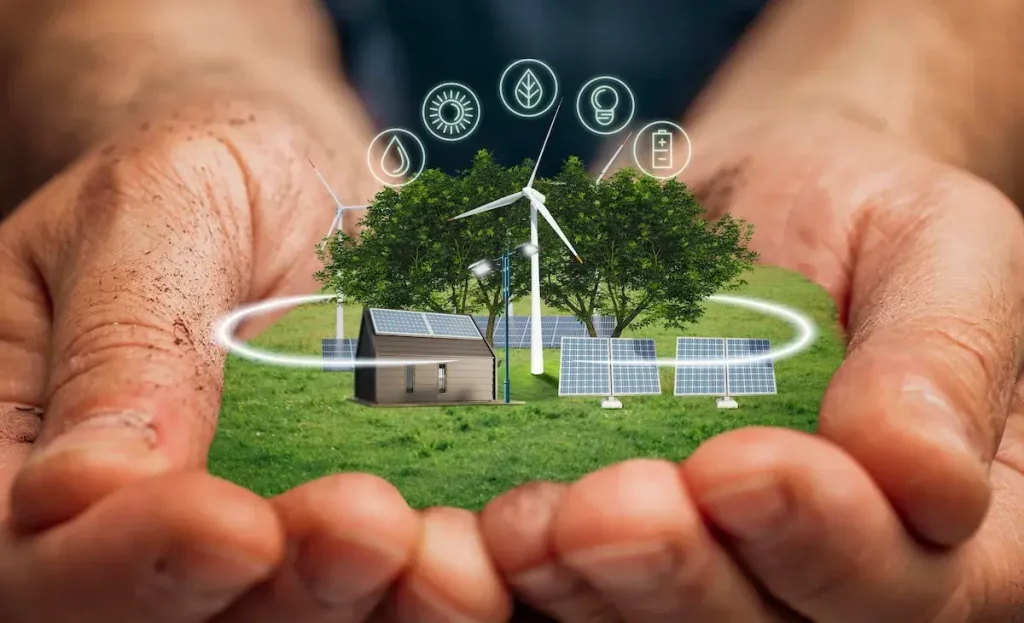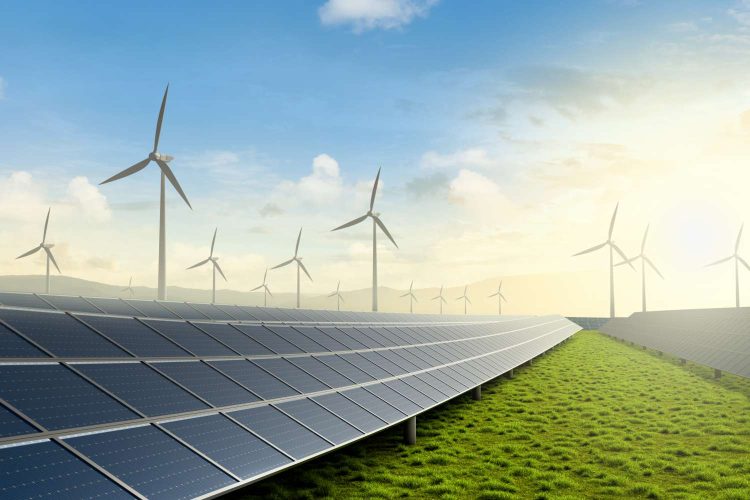1. Introduction: The Physics of a Civilization in Transition
Human civilization has always been shaped by energy. The mastery of fire enabled primitive societies to survive; coal and steam powered the Industrial Revolution; oil and electricity fueled the modern era. Today, humanity stands at another threshold — the transition from fossil fuels to renewable, green energy.
The global energy system, which supplies over 170,000 terawatt-hours (TWh) annually, is still dominated by carbon-based fuels that account for nearly 75% of greenhouse gas emissions. To mitigate climate change, stabilize ecosystems, and ensure sustainable economic growth, a full-scale energy transformation is underway.
But this revolution is not merely political or economic — it is profoundly scientific. Green energy technologies harness the immutable laws of physics and chemistry to convert natural, regenerative flows of energy — sunlight, wind, water, heat, and organic matter — into usable electricity and fuels. Understanding the underlying mechanisms of these systems reveals not only how they work, but how they can scale to power the 21st century.
2. Solar Energy: Engineering with Light
2.1 The Photovoltaic Revolution
The Sun delivers about 173,000 terawatts of energy to Earth’s surface every moment — more than 10,000 times humanity’s total consumption. Capturing even a small fraction could supply global demand indefinitely.
Solar cells operate based on the photoelectric effect, first explained by Albert Einstein in 1905. When photons strike a semiconductor material (such as silicon), their energy frees electrons, generating an electric current.
Key efficiency factors include:
- Bandgap energy (determines which photons can be absorbed)
- Quantum efficiency (ratio of photons to generated electrons)
- Series resistance and recombination losses
- Temperature effects (higher heat reduces voltage output)
Modern monocrystalline silicon PV cells reach 22–26% efficiency, while laboratory prototypes of multi-junction cells — layering materials like GaAs, InP, and perovskites — exceed 40% under concentrated sunlight.
2.2 Technological Breakthroughs
The 2020s have seen a renaissance in solar R&D:
- Perovskite-silicon tandem cells breaking the Shockley–Queisser limit
- Bifacial panels capturing reflected light from both sides
- Floating solar farms reducing land use and enhancing efficiency
- Building-integrated photovoltaics (BIPV) embedding solar materials into glass, walls, and infrastructure
These advances, coupled with plummeting production costs (a 90% price drop since 2010), have made solar the cheapest source of new electricity in most regions.
2.3 Concentrated Solar Power (CSP)
Unlike PV, CSP systems use mirrors to focus sunlight onto a receiver that heats a working fluid (like molten salt). The stored heat drives steam turbines and can be released at night, providing a rare combination of renewable and dispatchable energy.
Major projects such as Morocco’s Noor Solar Complex and Spain’s Gemasolar Plant demonstrate CSP’s scalability for national grids.
3. Wind Energy: Turning the Invisible into Power
3.1 The Mechanics of Wind Turbines
Wind energy is fundamentally a kinetic-to-electrical conversion governed by Betz’s Law, which caps the theoretical efficiency at 59.3%. Modern turbines typically achieve 45–50% of this limit, thanks to advanced aerodynamic blade designs and control systems.
Each turbine’s output scales with the cube of wind speed (v³) — a small increase in wind velocity can dramatically raise generation capacity. Offshore turbines, exposed to stronger and more stable winds, now dominate global installations.
3.2 Offshore Innovation and Scale
The latest 14–18 MW offshore turbines (such as GE’s Haliade-X) stand over 250 meters tall, with blades the length of a football field. Floating turbine platforms are expanding wind power to deeper seas once inaccessible.
New materials — carbon fiber composites, corrosion-resistant coatings, and 3D-printed components — have reduced maintenance and extended turbine lifespan to 25–30 years.
3.3 Digitalization and Predictive Control
Artificial intelligence and machine learning now optimize turbine yaw, pitch, and power curves in real time. Digital twins simulate entire wind farms to predict failures and improve efficiency, while superconducting generators promise further efficiency gains in the 2030s.
4. Hydropower and Marine Energy
4.1 Classical Hydropower
Hydropower remains the largest source of renewable electricity, generating over 4,200 TWh annually, about 16% of global supply. It operates on the principle of gravitational potential energy, converting falling or flowing water into mechanical rotation.
Modern run-of-river systems reduce environmental disruption compared to traditional large dams, providing flexible regional power. Pumped-storage hydropower (PSH) — using off-peak electricity to pump water uphill — acts as a giant battery for grid stability.
4.2 The Rise of Marine Energy
The world’s oceans are vast reservoirs of untapped energy:
- Tidal energy harnesses predictable gravitational cycles.
- Wave energy converters (WECs) transform oscillating water motion.
- Ocean current turbines extract kinetic energy from steady underwater streams.
- Ocean Thermal Energy Conversion (OTEC) exploits the temperature gradient between deep and surface waters.
While still early in commercialization, nations like the UK, Japan, and Portugal are investing heavily in pilot marine energy grids.
5. Geothermal Energy: Power from Beneath Our Feet
The Earth’s crust radiates heat from radioactive decay — a steady 47 terawatts globally. Geothermal energy taps into this immense resource.
5.1 Traditional vs. Enhanced Systems
- Dry steam and flash steam plants use naturally occurring hot water reservoirs.
- Binary cycle plants transfer heat to a working fluid with a lower boiling point.
- Enhanced Geothermal Systems (EGS) use drilling and hydraulic stimulation to create artificial heat reservoirs in hot dry rock.
With advanced drilling borrowed from the oil industry, EGS could unlock geothermal potential in almost any country, offering continuous, weather-independent clean power.

6. Bioenergy and Hydrogen: Chemical Frontiers of Green Power
6.1 Bioenergy
Through photosynthesis, plants store solar energy chemically. When converted via combustion, fermentation, or gasification, this energy can drive turbines or vehicles.
Innovations include:
- Second-generation biofuels from agricultural waste
- Algae-based fuels producing oil-rich biomass
- Biogas digesters converting organic waste into methane
Bioenergy also plays a key role in carbon-negative technologies like BECCS (Bioenergy with Carbon Capture and Storage), actively removing CO₂ from the atmosphere.
6.2 Hydrogen: The Element of the Future
Hydrogen contains three times the energy density of gasoline per kilogram, making it ideal for heavy transport and industrial processes.
There are three main types:
- Grey hydrogen: produced from natural gas, emits CO₂
- Blue hydrogen: includes carbon capture and storage
- Green hydrogen: generated by renewable-powered electrolysis
Electrolyzer efficiency has climbed to 80%, and global capacity is projected to exceed 100 GW by 2030, driven by EU, Japanese, and Chinese national strategies.
Hydrogen fuel cells, first commercialized by NASA, now power buses, ships, and data centers, converting hydrogen directly into electricity with only water as exhaust.
7. Energy Storage: The Bridge to a Renewable Grid
Without efficient storage, intermittent renewables cannot fully replace fossil fuels. Storage solutions vary by scale and purpose:
- Lithium-ion batteries: dominate short-term applications; prices have dropped 90% since 2010.
- Solid-state batteries: promise double energy density and enhanced safety.
- Flow batteries (vanadium, zinc-bromine): ideal for long-duration grid storage.
- Pumped hydro and compressed air: provide multi-day storage for national grids.
- Thermal energy storage: uses molten salts or phase-change materials for heating/cooling balance.
The world is entering the “Storage Decade”, where cost-effective energy retention is as transformative as renewable generation itself.
8. Smart Grids and Digital Energy Systems
The modern energy grid is evolving into a self-learning digital organism. Using sensors, AI, and IoT, smart grids coordinate distributed renewable generation, storage, and demand.
Key features include:
- Real-time monitoring via smart meters
- AI-driven load balancing to prevent blackouts
- Vehicle-to-grid (V2G) systems allowing EVs to store and return energy
- Blockchain-based peer-to-peer energy trading enabling local microgrids
Countries like Denmark, Singapore, and South Korea are pioneers in national-level smart grid deployment, merging data and energy into one intelligent infrastructure.
9. Research Frontiers and Global Collaboration
The frontier of green energy science lies in materials and integration:
- Perovskite durability (stability under moisture and heat)
- Next-gen catalysts for hydrogen electrolysis (reducing platinum use)
- Quantum materials for superconducting grids
- Artificial photosynthesis converting CO₂ into fuels directly using sunlight
Global initiatives such as Mission Innovation, IRENA, and the Paris Agreement frameworks have accelerated joint R&D across continents.
10. Challenges and Realities
Despite progress, the transition faces formidable obstacles:
- Resource constraints: rare earth elements, lithium, cobalt supply chains
- Recycling and end-of-life management: especially for PV panels and batteries
- Land and biodiversity conflicts: renewable siting near habitats
- Policy fragmentation: uneven subsidies and market distortions
Yet, with innovation and coordinated governance, these barriers are solvable. The energy transition is not merely a technological problem but a systems-level reorganization of civilization itself.
11. Conclusion: The Physics of Hope and Continuity
Green energy represents humanity’s effort to harmonize technological ambition with planetary limits. Each breakthrough — from perovskite solar cells to AI-optimized wind farms — is a testament to the power of science to serve life rather than exploit it.
The physics of green energy, in its essence, is the physics of continuity — the transformation of ephemeral natural flows into enduring power. It is not only a technological paradigm but a moral evolution, where intelligence becomes a form of stewardship.
As we enter the mid-21st century, our greatest challenge is no longer whether we can generate enough energy — it is whether we can generate it wisely, fairly, and forever.











































